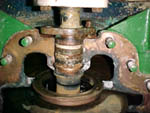 |
| stuffing box |
Stuffing boxes are still very common on ships; they are used to seal pumps, valves, stern tube etc. Setting these up to prevent leaks, and at the same time, keep them operational and cool is a bit of an art form. Sometimes, no matter how hard you try, it just won't seal to the desired level. This may be due to the improper packing procedures followed during the last packing job. Below you will find some information on how to deal with stuffing boxes...
PREPARATION
Completely remove the old packing from the stuffing box and
clean rod or shaft on which the packing is to be applied. Ensure that
the
surface of the shaft is smooth and free from scoring before
applying the packing.New packing is generally supplied in 6 ft. lengths, in sections up to 1" square. Packing above this size is generally supplied in the form of finished rings molded to suit the shaft diameter and the bore of the stuffing box. The packing in lengths must be cut with a sharp knife to suit the shaft diameter, with long scarfed ends so that the scarfing makes a good joint when placed in position around the shaft. The packing ring should be applied to the shaft as shown below, and must not be opened out straight.
METHOD OF PACKING
1. The dipping of each ring in lubricating oil before installation will help the packing, and careful attention given to the first running of the pump will add to the life of the packing and prevent any necessity for constant adjustment of the gland.2. Each ring should be installed separately and enter the stuffing box freely. Rotate the shaft after each ring is fitted and caulked home, using wooden strips or split metal followers which are a good fit in the stuffing box. Most packing compresses and unless this compression is taken up on each ring as it is fitted, the stuffing box will not be properly packed. Care must be taken to ensure that the joint of each ring is staggered with the previous one by 90' moving them progressively through 360 degrees.
3. When the stuffing box is full, apply the gland and compress the entire set until it feels solid, add an additional ring if it is necessary, then release gland slightly.
4. When screwing up the gland it is essential to ensure that the gland flange is parallel to the face of the stuffing box. If the gland is screwed up unevenly it imposes a greater pressure on the packing upon one side of the shaft, causing a side thrust; and if screwed up hard in this position tends to throw the shaft slightly off truth. Should the shaft be untrue or be forced even slightly off truth, due to uneven tightening of the gland, the shaft will force an eccentric bore through the packing when rotation commences, along which water under pressure will escape, or, what is more important, along which air will be drawn into the pump under vacuum.
6. It is important that clearances on the neck ring, lantern or gland are not excessive.
Great tips, many thanks for sharing. I have printed and will stick on the wall! I like this blog. Diesel Dewatering Pump
ReplyDelete